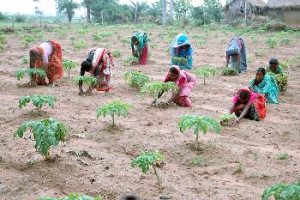 To increase the participation of women in the farm sector, women-friendly devices like head load manager, flower plucking device and cotton picking bag have been developed by an agricultural research institute.
To increase the participation of women in the farm sector, women-friendly devices like head load manager, flower plucking device and cotton picking bag have been developed by an agricultural research institute.
The Directorate of Research on Women in Agriculture, a constituent of Indian Council of Agricultural Research, is also in contact with entrepreneurs for commercial production of its innovative products and their marketing for enhancing efficiency of farm women.
"Since labour intensive methods of production are common in rural areas, it is important to develop technologies that can improve their labour efficiency and reduce drudgery," DRWA director Krishna Srinath said.
Listing technologies developed by the institution, she said an equipment called 'Head Load manager' has been prepared to relieve women of drudgery arising from lifting loads in farm yards, market yards and similar sites.
Noting that head loading method of transporting vegetables and other things was found drudgery prone, Srinath said the head load manager fabricated was found to bring in the desired change due to transfer of load impact on head to a broad base of shoulders and its evaluation.
Citing examples of other devices like cotton picking bag, pesticide spraying tool and flower plucking device, Anil Sharma of ICAR said, "New technologies developed by DWRA are specially designed to increase productivity by reducing fatigue and need to be popularised."
While the improved cotton bag with specially designed pockets increases work efficiency of women by 20 per cent and reduced muscle pressure by 40 to 50 per cent, by using head load manager 20 to 30 kg load per trip can be carried at a time, the DRWA director said.
Rural women have found all these technologies very useful in reducing drudgery, a senior scientist at the directorate said, adding that boosting farm women's efficiency is all the more important at a time marked by largescale migration of men from the sector.
As a result, the prospect of agricultural production, particularly in Orissa, would to a great extent depend on the size of female work force and their attitude towards farming, according to Srinath.
Quoting census data, DRWA scientists said the overall work participation rate in agriculture in Orissa has increased from over 31 per cent in 1971 to 38.8 per cent in 2001 against the national average of 39.26 per cent.
Among men, the work participation rate has slightly declined between 1971 and 2001, while among women the rate has increased from 10.5 per cent to 24.62 per cent, showing increasing participation of women in economic activities.
However, they felt that agriculture could face the constraints of labour availability for sustaining growth in the state in view of increasing investment and allocation in non-farm sector in rural areas.
Besides preparing innovative farm implements and tools suitable particularly for women, the DRWA has developed entrepreneurship development initiatives, special training programmes and a gender knowledge centre which are useful for self-help groups, Srinath said.
All these would increase awareness among SHGs about various seeds and planting material production, Sharma said, adding DRWA has also developed models for nutritional kitchen gardens, value addition of underutilised resources, agro-processing technologies and organic farming.
It has formed a data base -- 'nutriguide' -- with recipes from different parts of the country to educate women about low cost nutritious diet, the director said.
Models have also been developed for various activities like backyard poultry and aquaculture to empower women.
Plans are also afoot to engage women in para-extension activities at village level. "DRWA model involving research, panchayatiraj institutions and women groups presents an example worth replicating.







 © 2025
© 2025